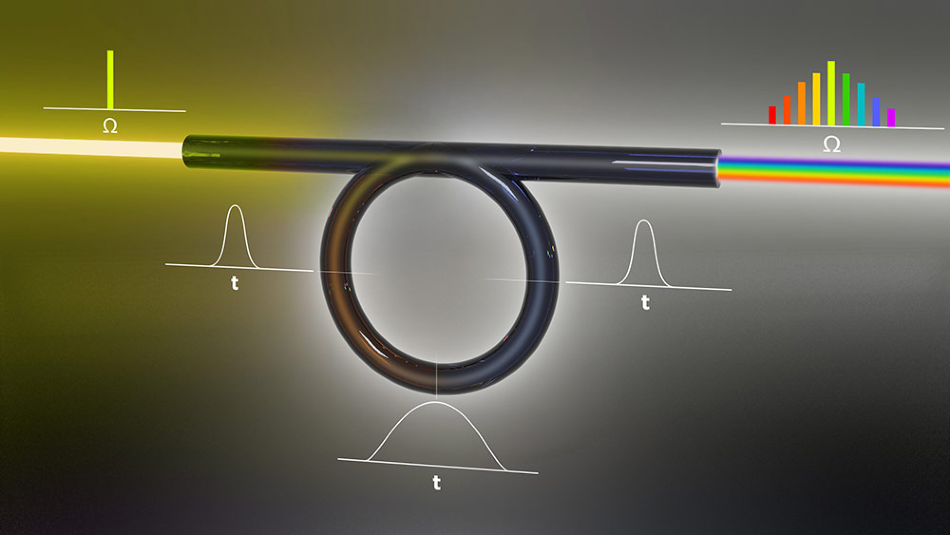Jul 27 2020
A group of scientists from the University of Rochester is setting a new benchmark for creating ultrafast laser pulses across a wider range of wavelengths when compared to conventional laser sources.
 In the stretched-pulse soliton Kerr resonator developed by the lab of William Renninger, a single-frequency laser enters a fiber ring cavity, generating a broad bandwidth comb of frequencies at the output that supports ultra-short femtosecond pulses. Inside the fiber cavity, the pulses stretch and compress in time, reaching a minimum duration twice in the cavity near the center of each of the two fiber sections. The stretching and compressing temporal evolution is a salient characteristic of femtosecond stretched-pulse soliton Kerr resonators. Image Credit: University of Rochester/Illustration by Michael Osadciw.
In the stretched-pulse soliton Kerr resonator developed by the lab of William Renninger, a single-frequency laser enters a fiber ring cavity, generating a broad bandwidth comb of frequencies at the output that supports ultra-short femtosecond pulses. Inside the fiber cavity, the pulses stretch and compress in time, reaching a minimum duration twice in the cavity near the center of each of the two fiber sections. The stretching and compressing temporal evolution is a salient characteristic of femtosecond stretched-pulse soliton Kerr resonators. Image Credit: University of Rochester/Illustration by Michael Osadciw.
William Renninger, an assistant professor of optics, together with members of his laboratory, has explained a novel device in a study published in the Physical Review Letters journal.
Called “stretched-pulse soliton Kerr resonator,” the device was able to improve the performance of ultrafast laser pulses. The study holds major implications for an array of biomedical and engineering applications, such as pulse generation, spectroscopy, distance ranging, frequency synthesis, etc.
An ultrafast laser pulse, which is on the order of femtoseconds, or equivalent to one-quadrillionth of a second, is produced by the new device. The laser pulse is freed from the physical confines that are prevalent in laser light sources—called laser gain by laser scientists—and also from the confines of the wavelengths of the sources.
Simply put, this is the shortest pulse ever from a gain-free fiber source.
William Renninger, Assistant Professor, The Institute of Optics, University of Rochester
Together with his group of graduate research and postdoctoral associates, Renninger further enhanced Kerr resonators, which is an interesting new alternative for producing femtosecond laser pulses. These laser pulses have been the topic of several studies.
The laboratory had successfully resolved a problem in pulse duration in other models of Kerr resonators by identifying a novel soliton—a localized envelope or brief burst of a wave—that keeps its shape even when propagating at a continuous velocity.
Within Renninger’s device, the solitons produced are different from those produced in other Kerr resonators, particularly the behavior and shape of the stretching pulses produced by them.
It is stable in the sense it keeps repeating the same thing over and over, getting longer, then shorter, longer then shorter.
William Renninger, Assistant Professor, The Institute of Optics, University of Rochester
The pulses “feature a broad spectral bandwidth and a compressed pulse duration of 210 femtoseconds, which is the shortest pulse duration observed to date from fiber Kerr resonators,” stated the scientists in the article.
Xue Dong is the study’s lead author and a graduate research associate in Renninger’s laboratory. Besides Renninger, other co-authors of the study are Qian Yang and Christopher Spiess, both graduate research associates in the laboratory, and also Victor Bucklew, a former postdoctoral associate in the laboratory.
The research was partly funded by the Technology Development Fund of the University of Rochester, the National Institutes of Health, and a University Research Award.
Making Ultrafast Lasers More Accessible
An expert in producing sources for femtosecond lasers, Renninger received his BS degree and PhD degree in applied physics from Cornell University. He worked as a postdoctoral associate as well as an associate research scientist at Yale University’s Department of Applied Physics and later joined the Institute of Optics at the University of Rochester.
A National Science Foundation CAREER award was recently given to Renninger. The award includes funds for creating an open source access to data for developing and producing next-generation laser sources that create femtosecond pulses.
There are now commercial products, but they’re very expensive. They are prohibitive for many research groups with limited budgets for equipment.
William Renninger, Assistant Professor, The Institute of Optics, University of Rochester
Since most of the cost goes in expertise and not for components, Renninger’s team will use only a part of the CAREER funding to offer consultation for research teams working at smaller universities on means for designing and building femtosecond lasers for fundamental studies.
“The ultimate goal is to have a design guide published on our website for everybody,” concluded Renninger.
Journal Reference:
Dong, X., et al. (2020) Stretched-Pulse Soliton Kerr Resonators. Physical Review Letters. doi.org/10.1103/PhysRevLett.125.033902.